The blue reference is from an old man driving a 99, The red compare trace is from a 13yr old in a 1.6 same day.
Top trace is a speed trace, middle trace is long G ( an inferred brake trace ), bottom graph is a time delta from the blue reference lap.
The first corner is represented by all the trace info to the left of the track map.
The top trace shows that the blue car is carrying about 2 miles an hour more speed down the straight at any given point. Means blue car got to power earlier than red car but wasn't necessarily producing more power as the speed delta is growing, only maintaining. Total top speed on the straight however is only a 1mph delta. Blue car 95.7, red car 94.6. Red car was able to collapse the 2 mph average speed delta by going longer down the straight before braking. Not just a little bit further but a bunch. Red car went about 60 feet further before it stopped accelerating.
Look at the shape of the middle long g traces. The blue car comes to brake earlier than the red car and has a fairly good, sharp, and consistent application of the brakes. However the pressure is fairly light as it only builds .5 long g, about half the brake force of the red car. The blue car then holds that pressure longer and is able to release the pressure as he begins trailing into the corner, rotating the car for the long sweeper, and releases the pressure consistently and with almost identical release of the brakes as they application of the brakes. The red car comes to the brakes softly, then briefly releases some pressure ( possibly from the heel toe downshift ), then hard and sharply hits the brakes. Just as sharply the red car releases the brakes. Then it appears that the red driver decides that they released too soon and had to slow the brake release at bit before fully releasing the brakes and coming to power.
The bottom delta line shows that the red car gained .3 second on the blue car that was traveling much faster down the straight. But because the blue car was completely gathered up for the corner and able to be DRIVEN through the corner instead of the car being RIDDEN through the corner. Not only did the blue car recover the .3 seconds on the exit, he gained another 2 tenths of a second. This same things happens on just about every corner. The red car goes harder and deeper only to spend more time than they gained gathering the car up and coming to power. So by the end of the lap, blue car has a second on the red car. Almost every corner shows the blue car coming to brakes earlier and lighter, with a better release than the red car.
The difference between people that can drive telling you to be light and early compared to deep and hard, IMO is a relative thing. Me saying light and early can be the exact same point and pressure as someone telling you to go deep and hard. So, IMO, it is more helpful for drivers trying to get from the back to the front, by talking about them being gathered up and the car fully settled and under their control before coming to power than it is to tell them to go deep and hard to make up time. It calibrates them to push it beyond their ability and right to the edge of anyone's ability to control. It is easy to brake late and hard and the new driver will easily do it. The problem is then turning the car and coming to a set where you can apply power. This is exactly what Ron and Steve and others are saying but we are just saying it differently. I think it is important how we tell drivers to do something because the terms we use are relative and not specific. For instance: Driver go deeper. Ok, how deep? But if I am applying the principles being taught, I am presumably faster out of the previous corner so braking at the same point is effectively going deeper!!! So deeper? Harder? Compared to what is easy, but how far and how much harder is tricky and variable.
As everyone has said, how you brake, especially the release is important. IMO, it will help your mind and training to concentrate on carrying more settled speed through the entire corner than it will by concentrating on taking the car in deep. My way calms the mind and the car. Trying to be the last of the late brakers stresses the mind and unsettles the car. Again, we can be talking about the exact same application and release of the brakes but described differently. Once the driver is turning good times and is settled in every corner, now with context you can ask the driver to go deeper. That is not the same as asking the driver to go deep.
( and I dont say you are wrong , I think he would say brake hardest and latest possible without compromising entry, apex speed and wot application)




 Sign In
Sign In Create Account
Create Account











 Back to top
Back to top Report
Report




